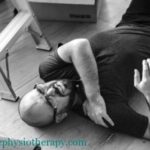Pes anserinus is the common tendon of Gracilis, Sartorius, and Semitendinosus muscles attached on the medial side of the knee. Pes anserinus bursa is present under this tendon and helps in reducing friction between the tendon and underlying bone.
Inflammation of this common tendon is referred to as Pes Anserinus tendonitis and Pes Anserinus bursitis for the inflammation of the bursa. Due to their close anatomical relationship, these conditions often occur together.

Pes Anserinus Bursitis
Causes of Pes Anserinus Bursitis:
The factors that can predispose a person to Pes Anserinus tendonitis include
- Repetitive use of this tendon in activities like running, dancing, and sports which require frequent direction changes (e.g. soccer, basketball),
- Abnormal biomechanics of hip, knee, or ankle,
- Underlying knee pathology (e.g. OA),
- Inadequate warm-up and cool down,
- Muscle imbalances,
- Inappropriate footwear,
- A sudden increase in activity level or sports training.
Symptoms of Pes Anserinus Bursitis
The patient may experience one or more symptoms of Pes Anserinus Bursitis/Tendonitis mentioned below –
- Pain on the inner aspect of knee with/or without movement
- Inner knee pain while ascending/ descending stairs
- Weakness in knee musculature
- Swelling over the inner aspect of the knee
- Pain and swelling limiting complete knee movement
Diagnosis
On examination, the physiotherapist will observe signs and symptoms related to Pes Anserinus tendinitis.
An MRI or diagnostic ultrasound may also be used to confirm the diagnosis.
Treatment of Pes Anserinus Bursitis
Patients with Pes Anserinus tendonitis start to feel better within a couple of weeks of the injury.
The physiotherapy treatment aims at:
- Reduce pain and inflammation.
- Normalize joint range of motion.
- Stretch tight muscles around the knee
- Strengthening knee muscles: especially quadriceps,
- Strengthening other lower limbs: calves, hip, and pelvis muscles.
- Improve patellofemoral alignment
- Improve proprioception and balance
- Improve overall functionality in activities like walking, running, squatting, hopping, and jumping.
- Minimize the chance of re-occurrence.
We suggest you consult PAIN-FREE PHYSIOTHERAPY CLINIC to understand your condition better and avail better treatment from experts at our clinic.
Most of the patients recover completely with physiotherapy management. An injection of hydrocortisone may be required at times if symptoms don’t settle in a couple of week’s treatment.
Prevention
Points to consider to reduce the risk of developing Pes Anserinus Tendonitis include:
- Correction of exercise technique
- Adequate warm-up and cool down before and after exercise
- Correction of muscle imbalances
- Appropriate footwear during exercise
- Gradual increase in training intensity/quantity





